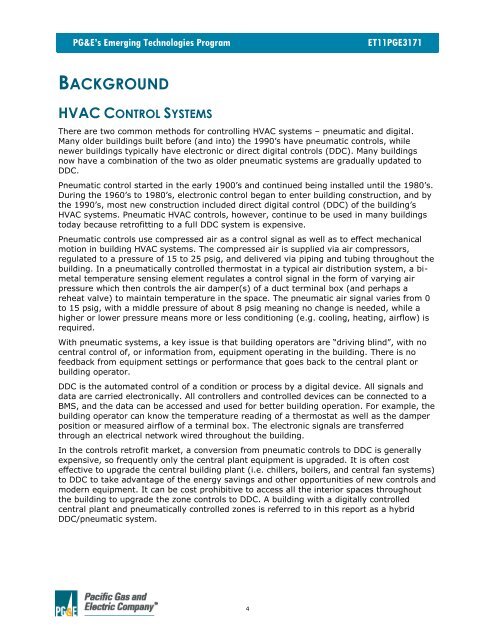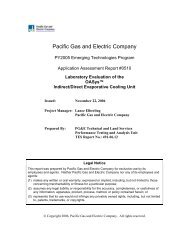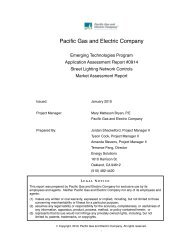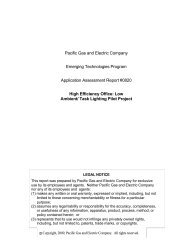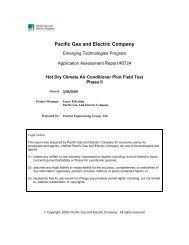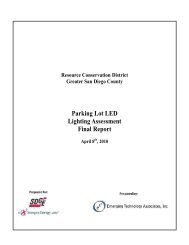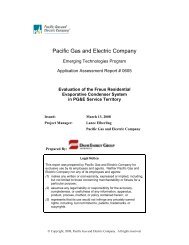PGE Wireless Pneumatic Thermostat ET Final Report.pdf
PGE Wireless Pneumatic Thermostat ET Final Report.pdf
PGE Wireless Pneumatic Thermostat ET Final Report.pdf
Create successful ePaper yourself
Turn your PDF publications into a flip-book with our unique Google optimized e-Paper software.
PG&E’s Emerging Technologies Program <strong>ET</strong>11<strong>PGE</strong>3171<br />
BACKGROUND<br />
HVAC CONTROL SYSTEMS<br />
There are two common methods for controlling HVAC systems – pneumatic and digital.<br />
Many older buildings built before (and into) the 1990’s have pneumatic controls, while<br />
newer buildings typically have electronic or direct digital controls (DDC). Many buildings<br />
now have a combination of the two as older pneumatic systems are gradually updated to<br />
DDC.<br />
<strong>Pneumatic</strong> control started in the early 1900’s and continued being installed until the 1980’s.<br />
During the 1960’s to 1980’s, electronic control began to enter building construction, and by<br />
the 1990’s, most new construction included direct digital control (DDC) of the building’s<br />
HVAC systems. <strong>Pneumatic</strong> HVAC controls, however, continue to be used in many buildings<br />
today because retrofitting to a full DDC system is expensive.<br />
<strong>Pneumatic</strong> controls use compressed air as a control signal as well as to effect mechanical<br />
motion in building HVAC systems. The compressed air is supplied via air compressors,<br />
regulated to a pressure of 15 to 25 psig, and delivered via piping and tubing throughout the<br />
building. In a pneumatically controlled thermostat in a typical air distribution system, a bimetal<br />
temperature sensing element regulates a control signal in the form of varying air<br />
pressure which then controls the air damper(s) of a duct terminal box (and perhaps a<br />
reheat valve) to maintain temperature in the space. The pneumatic air signal varies from 0<br />
to 15 psig, with a middle pressure of about 8 psig meaning no change is needed, while a<br />
higher or lower pressure means more or less conditioning (e.g. cooling, heating, airflow) is<br />
required.<br />
With pneumatic systems, a key issue is that building operators are “driving blind”, with no<br />
central control of, or information from, equipment operating in the building. There is no<br />
feedback from equipment settings or performance that goes back to the central plant or<br />
building operator.<br />
DDC is the automated control of a condition or process by a digital device. All signals and<br />
data are carried electronically. All controllers and controlled devices can be connected to a<br />
BMS, and the data can be accessed and used for better building operation. For example, the<br />
building operator can know the temperature reading of a thermostat as well as the damper<br />
position or measured airflow of a terminal box. The electronic signals are transferred<br />
through an electrical network wired throughout the building.<br />
In the controls retrofit market, a conversion from pneumatic controls to DDC is generally<br />
expensive, so frequently only the central plant equipment is upgraded. It is often cost<br />
effective to upgrade the central building plant (i.e. chillers, boilers, and central fan systems)<br />
to DDC to take advantage of the energy savings and other opportunities of new controls and<br />
modern equipment. It can be cost prohibitive to access all the interior spaces throughout<br />
the building to upgrade the zone controls to DDC. A building with a digitally controlled<br />
central plant and pneumatically controlled zones is referred to in this report as a hybrid<br />
DDC/pneumatic system.<br />
4


